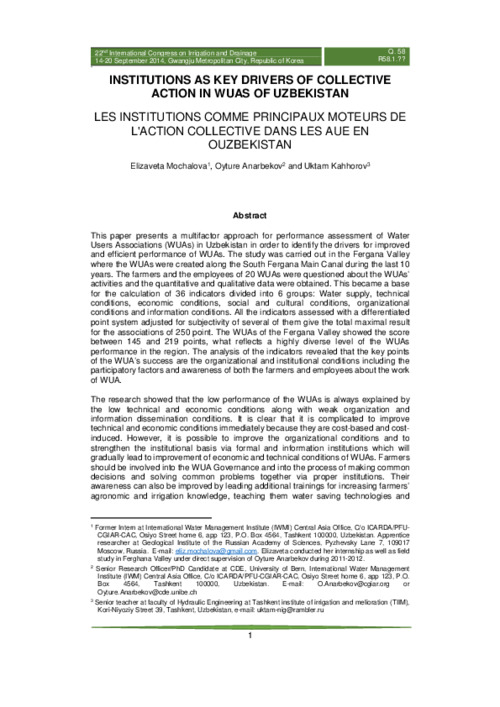Institutions as Key Drivers of Collective Action in WUAs of Uzbekistan
Abstract
This paper presents a multifactor approach for performance assessment of Water
Users Associations (WUAs) in Uzbekistan in order to identify the drivers for improved
and efficient performance of WUAs. The study was carried out in the Fergana Valley
where the WUAs were created along the South Fergana Main Canal during the last 10
years. The farmers and the employees of 20 WUAs were questioned about the WUAs’
activities and the quantitative and qualitative data were obtained. This became a base
for the calculation of 36 indicators divided into 6 groups: Water supply, technical
conditions, economic conditions, social and cultural conditions, organizational
conditions and information conditions. All the indicators assessed with a differentiated
point system adjusted for subjectivity of several of them give the total maximal result
for the associations of 250 point. The WUAs of the Fergana Valley showed the score
between 145 and 219 points, what reflects a highly diverse level of the WUAs
performance in the region. The analysis of the indicators revealed that the key points
of the WUA’s success are the organizational and institutional conditions including the
participatory factors and awareness of both the farmers and employees about the work
of WUA.
The research showed that the low performance of the WUAs is always explained by
the low technical and economic conditions along with weak organization and
information dissemination conditions. It is clear that it is complicated to improve
technical and economic conditions immediately because they are cost-based and costinduced.
However, it is possible to improve the organizational conditions and to
strengthen the institutional basis via formal and information institutions which will
gradually lead to improvement of economic and technical conditions of WUAs. Farmers
should be involved into the WUA Governance and into the process of making common
decisions and solving common problems together via proper institutions. Their
awareness can also be improved by leading additional trainings for increasing farmers’
agronomic and irrigation knowledge, teaching them water saving technologies and acquainting them with the use of water measuring equipment so it can bring reliable
water supply, transparent budgeting and adequate as well as equitable water allocation
to the water users

